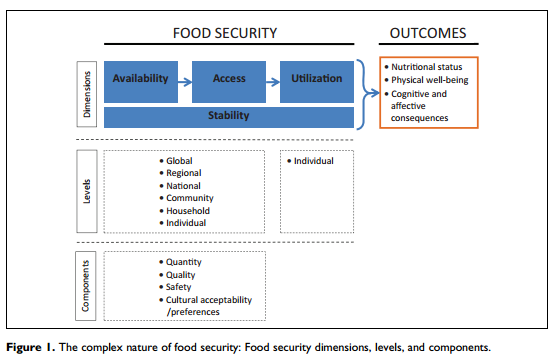
Food security is a simple phrase that encompasses an incredibly complex concept. The commonly accepted definition of food security, established by the FAO in 1996, states that food security exists “‘when all people, at all times, have physical, social, and economic access to sufficient, safe, and nutritious food to meet their dietary needs and food preferences for an active and healthy life.’’ Food security-related research and policies need to take into account a wide range of components –everything from the availability and stability of food sources, to food’s nutritional quality and safety, to people’s ability to eat foods that meet their cultural needs and personal preferences. But while researchers have established a wide range of indicators to address food security, it is often unclear which component or dimension of food security these indicators are intended, and able, to examine.
A new article in Food and Nutrition Bulletin looks at the specific dimension of food access at the individual and household levels and provides a detailed review of nine indicators commonly used when measuring people’s access to food:
- Household Food Security Scale Module (HFSSM)
- Latin American and Caribbean Food Security Scale (ELCSA)
- Household Food Insecurity Access Scale (HFIAS)
- Household Hunger Scale (HHS)
- Coping Strategy Index (CSI)
- Reduced CSI
- Household Dietary Diversity Score (HDDS)
- Infant and Young Child Dietary Diversity Score (IYCDDS)
- Women’s and Individual Dietary Diversity Score (WDDS and IDDS)
The review includes each indicator’s original purpose and construction, how they have been used in past research, and whether they are valid (i.e., they accurately reflect what they are intended to reflect) and equivalent (i.e., they can be used to make valid comparisons across multiple contexts). These specific indicators were chosen because they are easy for people to respond to and are thus particularly useful for large surveys in developing countries. The authors group these indicators into experience-based (HFSSM, ELCSA, HFIAS, HHS), coping strategies (CSI, Reduced CSI), and dietary diversity indicators (HDDS, IYCDDS, WDDS, IDDS).
They find that experience-based indicators can be useful for monitoring changes over time in food access within a particular population, that coping strategies are helpful in understanding behavioral responses to food insecurity, and that dietary diversity scores can accurately measure food intake. The authors conclude that no single indicator can truly capture all of the complexities of food security. The nine studied indicators seem to adequately capture food quantity (in terms of energy levels provided by food) and the individual dietary diversity score indicators adequately capture food quality (in terms of micronutrients). However, all nine indicators miss other important components of food access, including food safety and if the food meets specific cultural requirements and personal tastes. In addition, the indicators are of varying validity. The authors note that the HFSSM, ELCSA, HFIAS, and HHS indicators have been validated in a number of contexts while the CSI indicator had not been fully tested and thus was rated of “unknown” validity.
The study also found that many publications that use these indicators aren’t particularly clear about which components of food access they reflect. For example, while the HDDS and FCS indicators are often used to measure food quality, they in fact rely on data related to dietary diversity, which does not necessarily equate to quality. Neither of these indicators has been evaluated in terms of its ability to measure dietary quality in terms of micronutrient content.
Finally, the authors point to the need for further validation of indicators with tests for reliability and performance. They also note that that research should balances indicators’ equivalence (balancing their ability to be accurately used in multiple contexts with their significance for specific conditions in specific locations). For example, while indicators that focus on the most severe forms of food insecurity, such as the HHS indicator, may be useful in comparing food insecurity experiences (specifically, food quantity) across multiple contexts and locations, their narrow view may make them less useful when measuring whether food meets cultural standards and personal preferences, as these tend to vary by location and individual.
To truly make a global impact, future food security research needs to take into account multiple indicators and use a common framework and common terminology. Researchers will also need to ensure that the indicators used are actually valid for the project’s stated purpose. This will require major investments into establishing large-scale, regular data collection efforts across a large number of countries.
